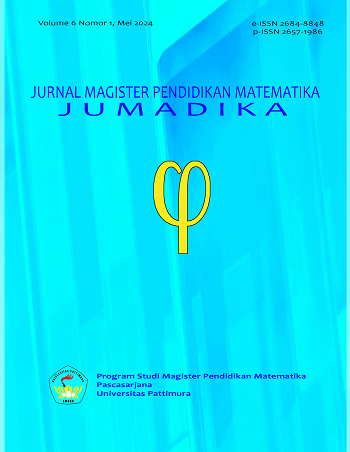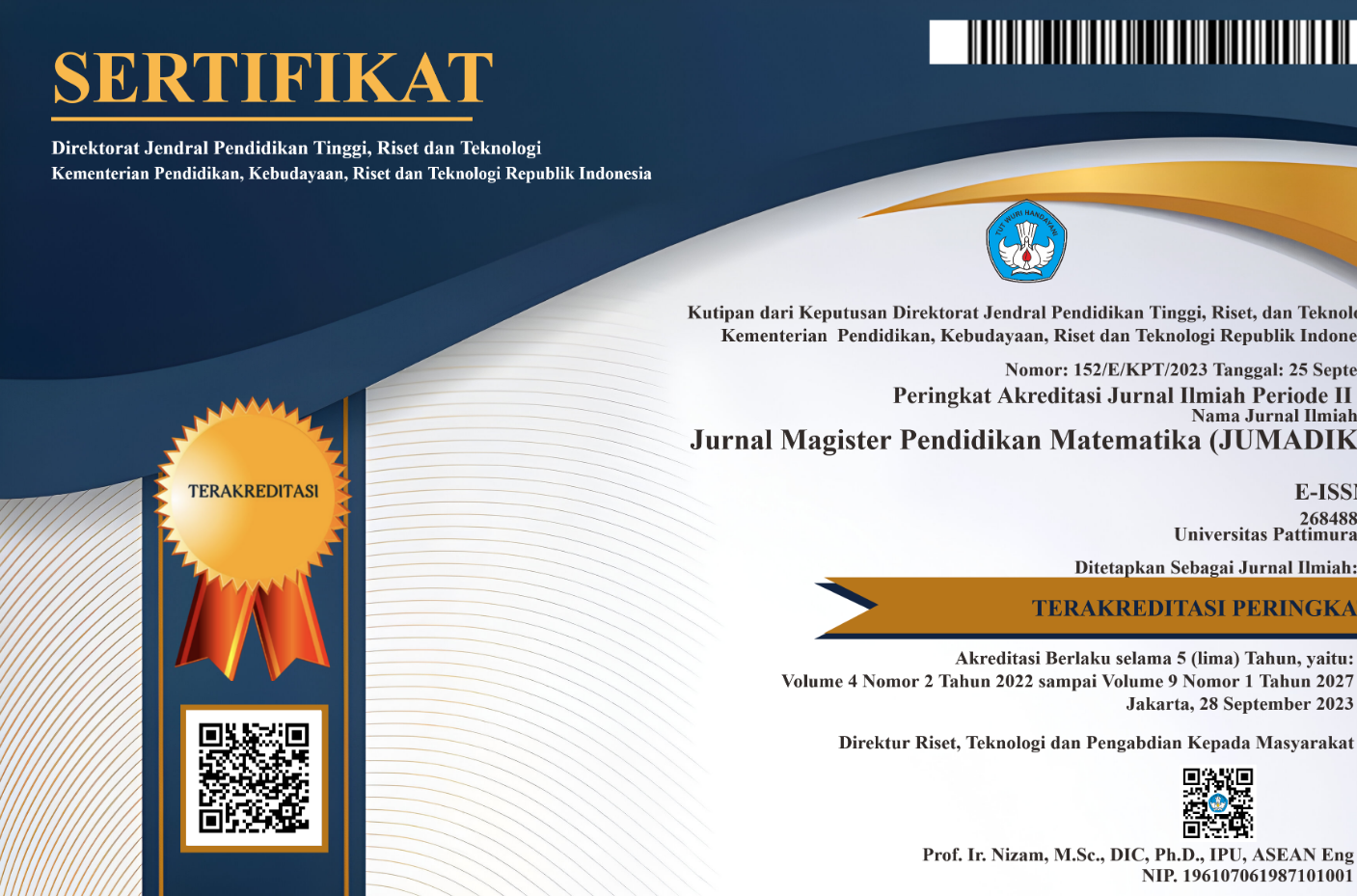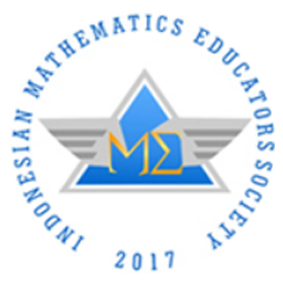IMPLEMENTATION OF THE FLIPPED CLASSROOM LEARNING MODEL TO DETERMINE STUDENTS' MATHEMATICAL SPATIAL ABILITY ON CUBE AND BLOCK MATERIAL IN GRADE VIII SMP
Abstract
This study aims to determine the implementation of the flipped classroom model in mathematics learning on the building materials of flat side spaces, cubes and blocks on students' spatial mathematical ability. The type of research used is quantitative Data collection method using observation sheets, tests, interviews, and documentation. The data were analyzed using quantitative descriptive and simple linear regression with prerequisite tests consisting of normality test and linearity test. The results of this study show that the implementation of the flipped classroom learning model is on very good criteria, with the average percentage of 4 meetings being 95%. The students' high mathematical spatial ability exceeded the minimum completeness criteria by 86% in the good category, judging from the 28 students who took the test, 24 students had completely exceeded the KKM. The implementation of the flipped classroom learning model has an effect on students' mathematical skills with a significance value of 0.000. The implementation of the flipped classroom learning model can improve students' mathematical spatial skills. This can be seen from the results of the final test of students who participated in the learning process. The use of WhatsApp groups and learning videos as a medium of communication and a source of learning for students at home. Learning in the classroom through assignment presentations and group discussions
Downloads
References
Abidin, M. (2019). Model Pembelajaran Flipped Classroom sebagai Upaya Peningkatan Kemampuan Penguasaan Rumus Transformasi Geometri. PEDAMATH Journal on Pedagogical Mathematics, 1(2), 49-60.
Andriani, T., Suastika, I. K., & Sesanti, N. R. (2017). Analisis kesalahan konsep matematika siswa dalam menyelesaikan soal trigonometri kelas X TKJ SMKN 1 Gempol tahun pelajaran 2016/2017. Pi: Mathematics Education Journal, 1(1), 34-39.
Chintia, M., Amelia, R., & Fitriani, N. (2021). Analisis kesulitan siswa pada materi bangun ruang sisi datar. JPMI (Jurnal Pembelajaran Matematika Inovatif), 4(3), 579-586.
Darma, I. K., Karma, I. G. M., & Santiana, I. M. A. (2020, February). Blended Learning, Inovasi Strategi Pembelajaran Matematika di Era Revolusi Industri 4.0 Bagi Pendidikan Tinggi. In PRISMA, Prosiding Seminar Nasional Matematika (Vol. 3, pp. 527-539).
Handayani, L., Pardimin, P., & Wijayanto, Z. (2021). Pengembangan Perangkat Pembelajaran Matematika Berbasis Flipped Classroom pada Sekolah Menengah Pertama. UNION: Jurnal Ilmiah Pendidikan Matematika, 9(3), 341-352.
Hanifah, H., Supriadi, N., & Widyastuti, R. (2019). Pengaruh model pembelajaran e-learning berbantuan media pembelajaran edmodo terhadap kemampuan pemecahan masalah matematis peserta didik. NUMERICAL: Jurnal Matematika Dan Pendidikan Matematika, 31-42.
Khoirotunnisa, A. U., & Irhadtanto, B. (2019). Pengaruh Model Pembelajaran Flipped Classroom Tipe Traditional Flipped Terhadap Hasil Belajar Matematika Siswa Pada Materi Bangun Ruang Sisi Datar.
Nasution, S. D., & Harahap, M. S. (2019). Efetivitas model pembelajaran flipped classroom terhadap kemampuanpenalaran matematis siswa. JURNAL MathEdu (Mathematic Education Journal), 2(3), 96-102.
Rambe, K. U. (2021). Analisis Kesulitan Siswa Dalam Menyelesaikan Masalah Spasial Dengan Pembelajaran Penemuan Terbimbing Berbasis Website Di SMA Negeri 1 Silangkitang (Doctoral dissertation, UNIMED).
Rasyid, A. L. A., & Irsan, I. (2022). Pelatihan Pembuatan Media Pembelajaran Matematika Menggunakan Aplikasi Geogebra pada Guru Sekolah Dasar. Jurnal Abdidas, 3(1), 53-60.
Rohman, R., Andinasari, A., & Wasiran, Y. (2022). Perancangan Prototype Multimedia Interaktif pada Materi Volume Bangun Ruang Sisi Lengkung untuk Siswa Sekolah Dasar. Indiktika: Jurnal Inovasi Pendidikan Matematika, 4(2), 119-128.
Syahputra, E. (2013). Peningkatan kemampuan spasial siswa melalui penerapan pembelajaran matematika realistik. Jurnal Cakrawala Pendidikan, 3(3).
Walidah, Z., Wijayanti, R., & Affaf, M. (2020). The Pengaruh Model Pembelajaran Flipped Classroom (FC) terhadap Hasil Belajar. Edumatica: Jurnal Pendidikan Matematika, 10(2), 71-77.
Winoto, Y., Aufa, N., & Anwar, R. K. (2020). Model literasi informasi pengajar dalam mengembangkan model kecerdasan ruang visual (spatial intelligence): Studi pada para peserta bimbingan belajar Villa Merah Bandung. Pustabiblia: Journal of Library and Information Science, 4(1), 59-78.
Copyright (c) 2024 Yoseph Watratan, Theresia Laurens, Carolina Selfisina Ayal

This work is licensed under a Creative Commons Attribution-NonCommercial-ShareAlike 4.0 International License.
License and Copyright Agreement
In submitting the manuscript to the journal, the authors certify that:
- They are authorized by their co-authors to enter into these arrangements.
- The work described has not been formally published before, except in the form of an abstract or as part of a published lecture, review, thesis, or overlay journal. Please also carefully read Jurnal Magister Pendidikan Matematika (JUMADIKA) Posting Your Article Policy.
- That it is not under consideration for publication elsewhere,
- That its publication has been approved by all the author(s) and by the responsible authorities – tacitly or explicitly – of the institutes where the work has been carried out.
- They secure the right to reproduce any material that has already been published or copyrighted elsewhere.
- They agree to the following license and copyright agreement.
Copyright
Authors who publish with Jurnal Magister Pendidikan Matematika (JUMADIKA) agree to the following terms:
- Authors retain copyright and grant the journal right of first publication with the work simultaneously licensed under a Creative Commons Attribution-NonCommercial-ShareAlike 4.0 International License (http://creativecommons.org/licenses/by-nc-sa/4.0/) that allows others to share the work with an acknowledgment of the work's authorship and initial publication in this journal.
- Authors are able to enter into separate, additional contractual arrangements for the non-exclusive distribution of the journal's published version of the work (e.g., post it to an institutional repository or publish it in a book), with an acknowledgment of its initial publication in this journal.
- Authors are permitted and encouraged to post their work online (e.g., in institutional repositories or on their website) prior to and during the submission process, as it can lead to productive exchanges, as well as earlier and greater citation of published work.








